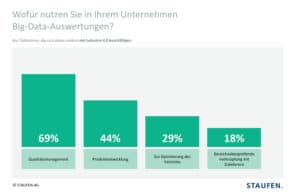
German industry primarily uses big data for quality management. Approximately seven out of ten companies with Industry 4.0 applications evaluate the data they generate during production in order to monitor the quality of their products. As the 2018 German Industry 4.0 Index from business consultancy Staufen shows, the electrical industry is leading the way. However, companies are far from really fully exploiting the potential of big data. Despite evaluating data, companies’ analyses have so far failed to trace the causes of quality problems, as a joint research project by Staufen and TU Darmstadt has demonstrated.
In the electrical industry, almost three-quarters of companies now use big data to control quality. In mechanical engineering, on the other hand, quality management (59%) and product development (51%) are almost on par.
“Companies have realized that data is an important basis for identifying and solving problems regarding quality. “However, they only use the information generated during production to a very limited extent,” Tobias Böing, Consultant at Staufen Quality Engineers GmbH (S.QE), a Staufen subsidiary specializing in quality management, explains. “Companies often limit themselves to determining deviations from specified standards or key figures. But the potential of data analyses (manufacturing analytics) has yet to be fully exploited for quality assurance.”
Taking a closer look at production data, however, provides insights into what causes quality problems and into interdependencies that are not initially visible. Together with the Institute for Production Management, Technology and Machine Tools (PTW) at TU Darmstadt, S.QE has investigated the possibilities of data analysis in the production process with regards to quality management in a research project. The result: a large proportion of industrial companies only use big data on a surface level (descriptive analytics). “Although companies create transparency in the production process, they are unable to make any statements about cause-and-effect relationships (diagnostic analytics). Even for higher-level applications such as predictive or prescriptive analytics for early detection of potential faults or for the automation of handling problems, the vital establishment of the causal relationship is missing,” says Tobias Böing.
As of now, the analysis (manufacturing analytics) necessary for comprehensive quality management can rarely be found in companies. There is simply a lack of know-how and software as well as suitable database structures. In addition, not all collected data is transferred to storage systems where it can be read and analyzed in the linked state. Instead, companies continue to use traditional QM methods, some of which are even done on paper and are gradually reaching their limits as the complexity of products and production networks increases.


